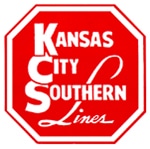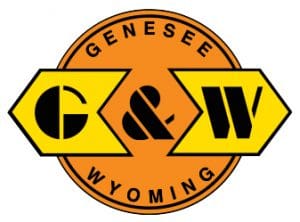In a move that has infuriated pilots and their unions, Congress has included allocations for research and implementation of single-piloted all-cargo flights into H.R. 4, the FAA reauthorization funding bill now under consideration.
Section 744 of the bill establishes a “research and development program in support of single-piloted cargo aircraft assisted with remote piloting and computer piloting” in conjunction with NASA and other relevant agencies.
On Aug. 1, unions representing the pilots of nearly 50 commercial airlines joined together at the 64th Air Safety Forum hosted by the Air Line Pilots Association, Int’l (ALPA) to express their opposition of what they’re calling a “dangerous set of provisions” added to the FAA reauthorization bill.
“ALPA adamantly opposes FAA Reauthorization Section 744 and will continue to use every resource we have to ensure that this anti-safety provision is not enacted,” wrote ALPA President Captain Tim Canoll in a joint press release with six other unions.
“Cargo and passenger carriers operate the same high-performance jet aircraft, share the same congested airspace, and fly over the same densely populated areas. There’s no logical reason to apply different standards to each,” wrote Capt. Dan Carey, president of the Allied Pilots Association (APA), in the same release.
H.R. 4 passed in the House of Representatives 393 – 13 on April 27. The bill now sits in the Senate where it has been placed on Legislative Calendar No. 401.
Click here to read the bill.
Author: amyr

This amendment would provide resources for maintenance and safety improvements along the Southwest Chief route and would compel Amtrak to fulfill its promise of matching funding for the successful TIGER IX discretionary grant supported by the Kansas Department of Transportation and local communities along the route. In addition, this amendment would effectively reverse Amtrak’s decision to substitute rail service with bus service over large segments of the route through FY2019.
“As the divide between urban and rural communities in America continues to expand, passenger rail services like the Southwest Chief are invaluable in connecting Kansans to the rest of the country while also bringing visitors from out of state to our local communities,” said Sen. Moran. “I applaud the bipartisan efforts to keep the Southwest Chief operational for our rural communities and will continue working with Amtrak to make certain this route remains available for the Kansans who need it.”
“For the second time in two weeks, the Senate is speaking out with strong, bipartisan support for long-distance rail, especially the Southwest Chief — and this time with $50 million in new funding,” said Sen. Udall. “Replacing rail service with bus service between Dodge City, Kansas and Albuquerque, New Mexico would not only have completely disrupted service for Amtrak passengers, it would have discouraged riders from taking the Southwest Chief in the first place, adding to Amtrak’s financial problems. The Southwest Chief route is an economic engine in New Mexico, giving passengers a ride through time — through the historic West — and connecting our communities. The additional funding from our amendment will make sure the Southwest Chief gets back on a sound financial track. I remain committed to working with our communities, Amtrak leadership, and other stakeholders to keep the Chief running long into the future.”
“I am pleased the Senate has approved our amendment to ensure continuous rail service on all long distance routes, especially the Southwest Chief,” said Sen. Roberts. “We heard from many Kansans strongly opposed to the proposed bus service within the route.”
“I’m excited to support an amendment that will greatly help the Southwest Chief’s continued presence in southeastern Colorado,” said Sen. Gardner. “The amendment secured by the bipartisan coalition in the appropriations bill will set aside funding for route improvements and enhancements, providing the opportunity to ensure the Southwest Chief stays in Colorado and continues servicing the rural areas that desperately need it.”
“The Southwest Chief is an important component of Southeastern Colorado’s tourism economy, and we will do all we can to preserve it,” said Sen. Bennet. “We’ll continue to work closely with lawmakers from Colorado—and also New Mexico and Kansas—to keep running the Southwest Chief through our state.”
“I’m proud to help lead this bipartisan coalition in the Senate to save the Southwest Chief, and I hope that my colleagues in the House of Representatives agree that fighting for infrastructure in rural America is good for our economy as a whole,” said Sen. Heinrich. “Each year, the Southwest Chief brings thousands of Boy Scouts from around the country to New Mexico’s Philmont Boy Scout Ranch and generates economic activity in our communities like Raton, Las Vegas, and Lamy. It makes no sense for Amtrak to provide inferior service while cutting out a key part of rural America. We’re going to continue fighting any effort to undermine this important route.”
The Southwest Chief runs daily between Chicago and Los Angeles and connects towns and cities in Kansas, Illinois, Missouri, Iowa, Colorado, New Mexico, Arizona and California and provides passenger train and long-distance passenger service, particularly through rural communities. The Southwest Chief stops in several Kansas communities including Lawrence, Topeka, Newton, Hutchinson, Dodge City and Garden City.
Items to Note:
- Last week, the Senate overwhelmingly passed a Sense of the Congress measure to affirm support for the long-distance rail service.
- Last month, the senators sent a letter to Amtrak’s CEO urging him to uphold Amtrak’s side of a longstanding public-private partnership to continue operating the Southwest Chief passenger train and long-distance passenger service.
- In May, the senators sent a bipartisan, multi-state letter condemning Amtrak’s decision not to match TIGER grant funds.
The above press release was released by Sen. Jerry Moran (R – Kan.) on Aug. 1, 2018, and originally appeared here.
Net Earnings: Increased 27 percent to C$1,310 million; diluted earnings per share increased 30 percent to C$1.77
Revenue: Increased 9 percent to C$3,631 million
Operating Income: Increased 7 percent to C$1,519 million
Operating Ratio: Increased 0.7 points to 58.2 percent (worsened as compared to the same period in 2017, but an improvement from the first quarter 2018)
Click here to read CN’s full earnings report.
Net Earnings: Decreased 9 percent to C$436 million from C$480 million; Diluted earnings per share declined 7 percent to C$3.04, down from C$3.27
Revenue: Increased 7 percent to C$1.75 billion from C$1.64 billion
Operating Income: Increased 3 percent to C$627 million
Operating Ratio: Increased 140 basis points to 64.2 as compared to last year’s 62.8 percent
Click here to read CP’s full earnings report.
Net Earnings: $877 million or $1.01 per share, up from $510 million or $0.55 per share
Revenue: Increased 6 percent to $3.10 billion
Operating Income: Increased 34 percent to $1.28 billion from $957 million
Operating Ratio: An all time company quarterly record of 58.6 percent as compared to last year’s 67.4 percent
Click here to read CSX’s full earnings report.
Net Earnings: Increased to $149 million or $1.45 per diluted share, as compared to last year’s $135 million or $1.27 per diluted share. Adjusted diluted earnings per share increased 16 percent to a record $1.54
Revenue: Increased 4 percent to a record $682 million
Operating Income: Increased 3 percent to a record $246 million
Operating Ratio: Increased 0.5 points to 64 percent as compared to 63.5 percent a year ago
Click here to read KCS’s full earnings report.
Net Earnings: Increased 43 percent to $710 million; Diluted earnings per share increased 46 percent to $2.50 per share
Revenue: Increased 10 percent to $2.9 billion
Operating Income: Increased 18 percent to a record $1.0 billion
Operating Ratio: A record 64.6 percent
Click here to read NS’s full earnings report.
Net Earnings: Increased to $1.5 billion from $1.2 billion, or a record $1.98 diluted earnings per share an increase of 37% from $1.45 per share
Revenue: Increased 5 percent to $2.1 billion
Operating Income: Increased 8 percent to $5.7 billion
Operating Ratio: Increased 1.1 points to 63.0 percent
Click here to read UP’s full earnings report.
Financial results of the largest U.S. shortline:
Net Earnings: Decreased to $44.2 million or $0.73 diluted earnings per share from $46 million or $0.74 per share
Revenue: Increased 7.6 percent to $339.6 million from $315.7 million
Operating Income: Increased 0.7 percent to $80.3 million from $79.7 million
Operating Ratio: Increased 1.6 points to 76.4 percent
Click here to read G&W’s full earnings report.
Notes:
- Operating ratio is a railroad’s operating expenses expressed as a percentage of operating revenue, and is considered by economists to be the basic measure of carrier profitability. The lower the operating ratio, the more efficient the railroad.
- All comparisons are made to 2017’s second quarter financial results for each railroad.
The public and members of Congress have been vocal in their displeasure with Amtrak’s announcements of cuts and planned cuts to service, including replacement of dining car service with boxed lunches on some routes, de-staffing 15 train stations around the country that serve less than 40 passengers per day and a proposal to substitute parts of the Southwest Chief train route with bus service.
Hot meals a thing of the past on select routes
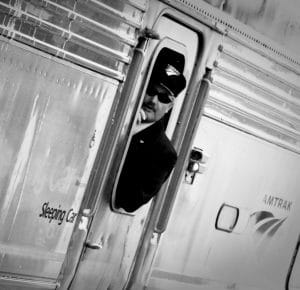
Julie King, executive director of the National Railroad Hall of Fame and the American Association of Private Railroad Car Owners, has expressed concern that the changes will dissuade customers from riding on trains.
“When you’re on a very long train trip, the equivalent of a boxed lunch is not going to enhance your experience,” King said. “The lack of train attendants has the same impact. It makes it difficult for people to get their questions answered and get tickets.”
De-staffing stations
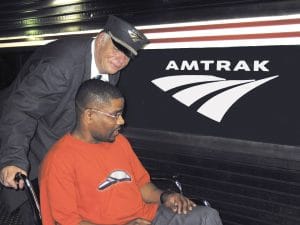
The staff cuts also have gotten the attention of senators. Ohio Sens. Rob Portman (R) and Sherrod Brown (D) have introduced an amendment to H.R. 6147, the 2019 fiscal transportation legislation, as a result of the de-staffing. If passed, the amendment would require Amtrak to staff any station that has averaged at least 25 passengers per day in the last five years.
“The services Amtrak staff provide are important to all passengers … but this is particularly true for elderly and disabled individuals who may have to carry baggage down to the train platform unassisted, often late at night,” Portman said.
Southwest Chief: train to bus service?
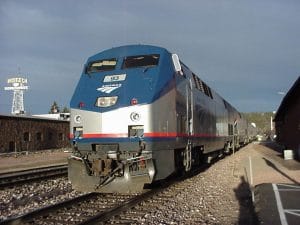
“The proposal would leave a 500-mile gap in the rail network, it would displace thousands of riders from the train and is projected to lose as much as 70 percent of current revenue generated,” the RPA said.
The RPA has started a petition on its website, www.railpassengers.org, in the hopes that Amtrak will reconsider its proposals.
SMART TD Colorado State Legislative Director Carl Smith said he is dismayed at the potential loss of jobs and the hardships that current passengers will face if Amtrak has its way.
“The Southwest Chief is critical infrastructure to sustaining good jobs in rural areas as well as providing passenger transportation to under-served areas that do not have ready access to other forms of travel to larger metropolitan areas,” Smith said.
The Texas Eagle Marketing and Performance Organization (TEMPO), which was created in the 1990s when Amtrak was looking to discontinue service on the Texas Eagle, a line that stops in Chicago; San Antonio; Fort Worth, Texas; and Los Angeles, has also been outspoken about the changes Amtrak is proposing.
“Over the years we’ve had to battle with Congress to fund these trains, but now it seems the battle is with Amtrak itself,” said TEMPO’s Dr. William Pollard after hearing about Amtrak’s planned cuts.
Members of Congress expressed their concern after Amtrak’s CEO Richard Anderson announced that he plans to renege on deals with affected states Amtrak had made under then-CEO Joe Boardman to keep the Southwest Chief running.
In a bipartisan letter to Amtrak’s Anderson, U.S. Sens. Marin Heinrich (D – N.M.), Tom Udall (D – N.M.), Michael Bennet (D – Colo.), Richard Durbin (D – Ill.), Tammy Duckworth (D – Ill), Dianne Feinstein (D – Calif.), Kamala Harris (D – Calif.), Pat Roberts (R – Kan.), Jerry Moran (R – Kan.) and Cory Gardner (R – Colo.) wrote: “The potential suspension of rail service has raised serious concerns among our constituents who depend on the Southwest Chief. We strongly disagree with such a decision and urge you to uphold Amtrak’s commitment to intercity rail service across the entire national network, particularly through our rural communities.”
The Senate has since passed an amendment to the chamber’s fiscal 2019 transportation legislation to force Amtrak to keep running its long-distance routes. Amendment No. 3414 of the funding bill H.R. 6147 says, “It is the sense of Congress that 1) long distance routes provide much needed transportation access to millions of riders in 325 communities in 40 states, and are particularly important in rural areas; and 2) long distance passenger rail routes and services should be sustained to ensure connectivity throughout the national network.”
That amendment passed, 95 to 4. The clear objective of the amendment is to tell Amtrak that it cannot be the sole decision-maker in the decision to scrap portions of the national network.
“Now, more than ever, we need a ‘national’ rail system. It’s sad that we need the representatives and senators of the people to mandate the CEO of Amtrak to continue to operate a national system instead of dismantling it,” said Dirk Sampson, general chairperson of Amtrak GO 769.
LCA Illinois Central Local Chairperson Todd W. Larson, 49, lost his battle with cancer on July 12. A member of Local 1299 in Chicago since March 2008, Larson held various positions with the local including local legislative representative and local alternate legislative representative.
“Todd did an excellent job representing our membership in Chicago, and his contributions to the labor movement are invaluable,” said General Chairperson Adren Crawford. “We are saddened by the news of his passing and send our deepest condolences to his family. He will be greatly missed.”
Larson is survived by his wife Christine Larson; daughters Meagan (Nathan) Dulny and Krystal Larson; mother Rita Larson; and grandchildren Zoe and Chloe Dulny. He was preceded in death by his father Terry Larson.
Services will take place Wednesday, July 18 at 7 p.m. at Thompson & Kuenster Funeral Home, 5570 W. 95th St., Oak Lawn, IL 60453.
In lieu of flowers, the family asks that a memorial donation be made to the charity of your choice.
Click here for Larson’s official obituary and to leave your condolences for the family.
States must receive FTA certification by April 15, 2019, or new federal transit funds cannot be awarded

Federal law requires states with rail transit systems to obtain FTA certification of their SSO Programs by April 15, 2019. By federal law, the deadline cannot be waived or extended.
“FTA is pleased that North Carolina, Puerto Rico and Washington have developed safety oversight programs that meet federal certification requirements and will strengthen rail transit safety,” said FTA Acting Administrator K. Jane Williams. “With this certification, transit agencies in the three jurisdictions can continue to receive federal funding.”
The North Carolina Department of Transportation is responsible for providing safety oversight of the Charlotte Area Transit System light rail and streetcar systems.
The Puerto Rico Emergency and Disaster Management Bureau is responsible for providing safety oversight of the Tren Urbano heavy rail system.
The Washington State Department of Transportation is responsible for providing safety oversight of the Sound Transit light rail systems and City of Seattle street car and monorail systems.
By April 15, 2019, 30 states must obtain certification of 31 SSO programs. With today’s announcement, 17 states have now achieved SSO program certification.
If a state fails to meet the deadline, FTA is prohibited by law from awarding any new federal transit funds to transit agencies within the state until certification is achieved. A certification status table by state is available online.
To achieve FTA certification, an SSO Program must meet several federal statutory requirements, including establishing an SSO agency that is financially and legally independent from the rail transit agencies it oversees. In addition, a state must ensure that its SSO agency adopts and enforces relevant federal and state safety laws, has investigatory authority and has appropriate financial and human resources for the number, size and complexity of the rail transit systems within the state’s jurisdiction. Furthermore, SSO agency personnel responsible for performing safety oversight activities must be appropriately trained.
The Federal Aviation Administration (FAA) was ordered by a judge in 2017 to address the issue of airlines shrinking the sizes of seats and legroom in order to add more seating on planes. The FAA has responded by ruling that seat shrinkage does not affect passenger safety and so they will not be setting limits on legroom or seat width.
“The FAA has no evidence showing that current seat dimensions hamper the speed of passenger evacuation, or that increased passenger size creates an evacuation issue,” an FAA spokesman told MarketWatch. “During an evacuation, passengers stand up in just a few seconds, which is less time than it takes for emergency exits to begin functioning and for the line that begins forming in the aisle to clear.”
NBC’s Today show reported on July 10 that U.S. airlines are planning to reduce their restroom sizes by three inches in an effort to add yet another seat.
Click here to read the full story from MarketWatch.
Big Blue Bus (BBB) operator and SMART TD member Rochelle Beamon (Local 1785) has been honored by Santa Monica, California’s city manager with the city’s “Elaine” award. Beamon has been labeled a hero after she managed to miss hitting a man on an electric scooter who swerved into her lane.
“I saw him, looked left and felt very grateful that it turned out the way it did. It feels great to know that I saved someone’s life,” Beamon said when she received the award.
Each week, City Manager Rick Cole honors someone with an “Elaine” award to a city employee who exemplifies the city’s commitment to excellent service.
SMART TD congratulates Beamon on her excellent driving skills and on a job well done.
Click here to read more from the Santa Monica Daily Press.
SMART TD represents bus operators who work for BBB in Santa Monica, Calif. BBB service area spans more than 58 square miles of greater Los Angeles and its buses provide over 16.5 million rides for customers each year.
OSHA’s campaign to keep workers safe in the heat
OSHA’s Heat Illness Prevention campaign, launched in 2011, educates employers and workers on the dangers of working in the heat. Through training sessions, outreach events, informational sessions, publications, social media messaging and media appearances, millions of workers and employers have learned how to protect workers from heat. OSHA’s safety message comes down to three key words: Water. Rest. Shade.
Dangers of working in the heat
Every year, dozens of workers die and thousands more become ill while working in extreme heat or humid conditions. More than 40 percent of heat-related worker deaths occur in the construction industry, but workers in every field are susceptible. There are a range of heat illnesses and they can affect anyone, regardless of age or physical condition.
Employer responsibility to protect workers
Under OSHA law, employers are responsible for providing workplaces free of known safety hazards. This includes protecting workers from extreme heat. An employer with workers exposed to high temperatures should establish a complete heat illness prevention program.
- Provide workers with water, rest and shade.
- Allow new or returning workers to gradually increase workloads and take more frequent breaks as they acclimatize, or build a tolerance for working in the heat.
- Plan for emergencies and train workers on prevention.
- Monitor workers for signs of illness.
Why is heat a hazard to workers?
When a person works in a hot environment, the body must get rid of excess heat to maintain a stable internal temperature. It does this mainly through circulating blood to the skin and through sweating.
When the air temperature is close to or warmer than normal body temperature, cooling of the body becomes more difficult. Blood circulated to the skin cannot lose its heat. Sweating then becomes the main way the body cools off. But sweating is effective only if the humidity level is low enough to allow evaporation, and if the fluids and salts that are lost are adequately replaced.
If the body cannot get rid of excess heat, it will store it. When this happens, the body’s core temperature rises and the heart rate increases. As the body continues to store heat, the person begins to lose concentration and has difficulty focusing on a task, may become irritable or sick, and often loses the desire to drink. The next stage is most often fainting and even death if the person is not cooled down.
Excessive exposure to heat can cause a range of heat-related illnesses, from heat rash and heat cramps to heat exhaustion and heat stroke. Heat stroke can result in death and requires immediate medical attention.
Exposure to heat can also increase the risk of injuries because of sweaty palms, fogged-up safety glasses, dizziness and burns from hot surfaces or steam.
Who could be affected by heat?
Workers exposed to hot indoor environments or hot and humid conditions outdoors are at risk of heat-related illness, especially those doing heavy work tasks or using bulky or non-breathable protective clothing and equipment. Some workers might be at greater risk than others if they have not built up a tolerance to hot conditions, or if they have certain health conditions. The table below shows some environmental and job-specific factors that increase the risk of heat-related illness.
| Factors that put workers at greater risk | |
| Environmental |
|
| Job-Specific |
|
Workers who are suddenly exposed to working in a hot environment face additional, but generally avoidable hazards to their safety and health. New workers and those returning from time away are especially vulnerable. That’s why it is important to prepare for the heat: educate workers about the dangers of heat, and acclimatize workers by gradually increasing the workload or providing more frequent breaks to help new workers and those returning to a job after time away build up a tolerance for hot conditions.
How do I know if it’s too hot?
- The temperature rises
- Humidity increases
- The sun gets stronger
- There is no air movement
- No controls are in place to reduce the impacts of equipment that radiates heat
- Protective clothing or gear is worn
- Work is strenuous
The heat index, which takes both temperature and humidity into account, is a useful tool for outdoor workers and employers (see Using the Heat Index: A Guide for Employers).
How can heat-related illness be prevented?
Heat-related illnesses can be prevented. Important ways to reduce heat exposure and the risk of heat-related illness include engineering controls, such as air conditioning and ventilation, that make the work environment cooler, and work practices such as work/rest cycles, drinking water often, and providing an opportunity for workers to build up a level of tolerance to working in the heat. Employers should include these prevention steps in worksite training and plans. Also, it’s important to know and look out for the symptoms of heat-related illness in yourself and others during hot weather. Plan for an emergency and know what to do — acting quickly can save lives!
> Go to Prevention
Heat-related Illnesses and First Aid

Heat stroke, the most serious form of heat-related illness, happens when the body becomes unable to regulate its core temperature. Sweating stops and the body can no longer rid itself of excess heat. Signs include confusion, loss of consciousness, and seizures. Heat stroke is a medical emergency that may result in death! Call 911 immediately.
Heat exhaustion is the body’s response to the loss of water and salt from heavy sweating. Signs include headache, nausea, dizziness, weakness, irritability, thirst and heavy sweating.
Heat cramps are caused by the loss of body salts and fluid during sweating. Low salt levels in muscles cause painful cramps. Tired muscles—those used for performing the work—are usually the ones most affected by cramps. Cramps may occur during or after working hours.
Heat rash, also known as prickly heat, is skin irritation caused by sweat that does not evaporate from the skin. Heat rash is the most common problem in hot work environments.
For more information about heat-related illnesses:
- OSHA campaign to prevent heat illness in outdoor workers
- OSHA technical manual (OTM) chapter – heat stress. OSHA Directive TED 01-00-015 [TED 1-0.15A], (September 15, 2017). Includes useful sections on heat illness, prevention programs, assessment and screening for heat stress in the workplace.
- Heat illness. National Institutes of Health, Medline Plus. Includes information in multiple languages.
- Heat: A major killer. National Oceanic and Atmospheric Administration (NOAA), National Weather Service. Links to the landing page with NWS’s heat index description and chart.
In a joint venture, Alaska’s White Pass and Yukon Route Railroad (WP&Y) is being sold to Survey Point Holdings (majority owners) and Carnival/Holland America (minority owners). The deal is set to be final Aug. 1.
“Both companies have experience operating in Southeast Alaska, specifically in port operations and tourism, which dovetails nicely with our MO,” White Pass Local Chairperson Chris Williams said. “Suffice to say, we are cautiously optimistic.”
Begun in 1898 during the Klondike Gold Rush, the WP&Y today caters to the tourist trade. The narrow-gauge railroad operates on the first 67.5 miles (Skagway, Alaska to Carcross, Yukon) of the original 110-mile line. The operation is designated as an International Historic Civil Engineering Landmark.
SMART TD Local 1626 represents train and engine service workers employed by the WP&Y.



